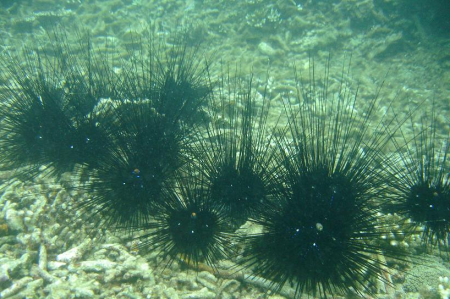According to the International Union for Conservation of Nature, Vietnam is a top country with great marine biodiversity in the world. It possesses many kinds of marine ecosystems, creatures, and genes. Currently, we have studied and acknowledged 20 types of marine ecosystems, such as estuary, mangrove forest, protection forest, coral reef, seagrass, and 11,000 species of living creatures, many of which are of high economic value.
 |
| Several marine living creatures of Vietnam (photo: vast.ac.vn) |
Over the past years, our Party and State have issued many policies and implemented a number of measures to conserve and develop marine biodiversity. Until 2018, across the country, 10 marine protected zones were established and greatly contributed conserving marine ecosystems and precious, rare species of marine creatures, developing marine economy in line with the struggle for defending the national sovereignty and security in the Exclusive Economic Zone, and coordinating the settlement of cross-border environmental issues in the East Sea.
However, besides the recorded results, our country’s mechanisms and policies for reserving and developing marine biodiversity have yet to be synchronized; the management and exploitation of national and international marine protected zones have yet to be close or effective. The public awareness of conservation of marine biodiversity has been insufficient. The free, widespread exploitation of marine resources has destroyed marine ecosystems. In addition, marine environment pollution due to oil spill and waste, climate change, and especially the building of mangrove forests, lagoons, and shoals into aquaculture zones as well as the urbanization and rapid, large-scale development of facilities have negatively impacted on the conservation and development of marine biodiversity.
Against that backdrop, the 12th Party Central Committee’s Resolution 36-NQ/TW, dated October 22nd 2018, on “the Strategy for the sustainable development of Vietnam’s marine economy towards 2030, with a vision towards 2045” set up the targets: “Marine, coastal and island ecosystems will be properly managed and protected. The area of marine and coastal conservation zones will increase to at least 6% of the natural area of the country’s maritime zones; the coastal mangrove forest area will be restored to at least equal to the area in 2000”.
To achieve those targets, first of all, competent offices, local party committees and authorities, and coastal and island people should raise their awareness and responsibility towards the conservation and development of marine biodiversity under the Law on Biodiversity. At the same time, functional offices should continue studying, adjusting, supplementing, and completing the system of policies and laws in order to facilitate and closely manage the exploitation, conservation, and development of marine biodiversity. They should closely cooperate with international organizations for conservation of nature, build and broadcast Vietnam’s trademark, exploit the potential of endemic species, and marine ecosystems and resources in the development of tourism and marine economy. Due regard should be paid to expanding the area and establishing marine protected zones based on the national plan for marine space as well as conserving and restoring marine ecosystems and biodiversity. Moreover, it is necessary to closely combine the investment in technical facilities for conserving and developing marine biodiversity with diversification of forms and measures for dealing with climate change, marine environment incidents, and factors threatening the survival of marine species, thereby facilitating the sustainable development of marine economy in particular, the socio-economic development in general.
Nguyen Duc Phu